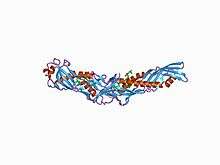Lipid-binding serum glycoprotein
In molecular biology, the lipid-binding serum glycoproteins family, also known as the BPI/LBP/Plunc family or LBP/BPI/CETP family represents a family which includes mammalian lipid-binding serum glycoproteins. Members of this family include:
- Bactericidal permeability-increasing protein (BPI)[1]
- Lipopolysaccharide-binding protein (LBP)[2]
- Cholesteryl ester transfer protein (CETP)
- Phospholipid transfer protein (PLTP)[3]
- Palate, lung and nasal epithelium carcinoma-associated protein (PLUNC)
| LBP / BPI / CETP family, N-terminal domain | |||||||||
|---|---|---|---|---|---|---|---|---|---|
 crystal structure of bpi, the human bactericidal permeability-increasing protein | |||||||||
| Identifiers | |||||||||
| Symbol | LBP_BPI_CETP | ||||||||
| Pfam | PF01273 | ||||||||
| InterPro | IPR017942 | ||||||||
| PROSITE | PDOC00367 | ||||||||
| SCOPe | 1bp1 / SUPFAM | ||||||||
| TCDB | 1.C.40 | ||||||||
| OPM superfamily | 170 | ||||||||
| OPM protein | 2obd | ||||||||
| |||||||||
| LBP / BPI / CETP family, C-terminal domain | |||||||||
|---|---|---|---|---|---|---|---|---|---|
 crystal structure of bpi, the human bactericidal permeability-increasing protein | |||||||||
| Identifiers | |||||||||
| Symbol | LBP_BPI_CETP_C | ||||||||
| Pfam | PF02886 | ||||||||
| InterPro | IPR001124 | ||||||||
| PROSITE | PDOC00367 | ||||||||
| SCOPe | 1bp1 / SUPFAM | ||||||||
| TCDB | 1.C.40 | ||||||||
| |||||||||
Structure
These proteins consist of N- and C-terminal domains, which share a similar two-layer alpha/beta structure, but show little sequence identity to each other.
Function
Bactericidal permeability-increasing protein
Bactericidal permeability-increasing protein (BPI) is a potent antimicrobial protein of 456 amino acids that binds to and neutralises lipopolysaccharides from the outer membrane of Gram-negative bacteria.[4] BPI contains two domains that adopt the same structural fold, even though they have little sequence similarity.[5]
Lipopolysaccharide-binding protein
Lipopolysaccharide-binding protein (LBP) is an endotoxin-binding protein that is closely related to, and functions in a co-ordinated manner with BPI to facilitate an integrated host response to invading Gram-negative bacteria.[6]
Cholesteryl ester transfer protein
Cholesteryl ester transfer protein (CETP) is a glycoprotein that facilitates the transfer of lipids (cholesteryl esters and triglycerides) between the different lipoproteins that transport them through plasma, including HDL, LDL, VLDL and chylomicrons. These lipoproteins shield the lipids from water by encapsulating them within a coating of polar lipids and proteins.[7]
Phospholipid transfer protein
Phospholipid transfer protein (PLTP) exchanges phospholipids between lipoproteins and remodels high-density lipoproteins (HDLs).[8]
Palate, lung and nasal epithelium carcinoma-associated protein
Palate, lung and nasal epithelium carcinoma-associated protein (PLUNC) is a potential host defensive protein that is secreted from the submucosal gland to the saliva and nasal lavage fluid. PLUNC appears to be a secreted product of neutrophil granules that participates in an aspect of the inflammatory response that contributes to host defence.[9]
Short palate, lung and nasal epithelium clone 1 (SPLUNC1) may bind the lipopolysaccharide of Gram-negative nanobacteria, thereby playing an important role in the host defence of nasopharyngeal epithelium.[10]
Bacterial permeability family member A1 (BPIFA1/SPLUNC1) is an innate protein that is secreted basolaterally from healthy, but not asthmatic, human bronchial epithelial cultures (HBECs). It suppresses airway smooth muscle contractility by binding to and inhibiting the Ca2+ influx channel Orai1.[11]
Human proteins belonging to this family
BPI; BPIL1; BPIL2; BPIL3; CETP; LBP; LPLUNC1; LPLUNC3; LPLUNC4; PLTP; PLUNC; SPLUNC2;
References
- Gray PW, Flaggs G, Leong SR, Gumina RJ, Weiss J, Ooi CE, Elsbach P (1989). "Cloning of the cDNA of a human neutrophil bactericidal protein. Structural and functional correlations". J. Biol. Chem. 264 (16): 9505–9509. PMID 2722846.
- Gray PW, Leong SR, Wright SD, Schumann RR, Flaggs GW, Mathison JC, Tobias PS, Ulevitch RJ (1990). "Structure and function of lipopolysaccharide binding protein". Science. 249 (4975): 1429–1431. doi:10.1126/science.2402637. PMID 2402637.
- Grant FJ, Day JR, Albers JJ, Lofton-Day CE, Gilbert TL, Marcovina SM, Adolphson JL, O Hara PJ, Ching AF (1994). "Complete cDNA encoding human phospholipid transfer protein from human endothelial cells". J. Biol. Chem. 269 (12): 9388–9391. PMID 8132678.
- Beamer LJ, Carroll SF, Eisenberg D (June 1997). "Crystal structure of human BPI and two bound phospholipids at 2.4 angstrom resolution". Science. 276 (5320): 1861–4. doi:10.1126/science.276.5320.1861. PMID 9188532.
- Kleiger G, Beamer LJ, Grothe R, Mallick P, Eisenberg D (June 2000). "The 1.7 A crystal structure of BPI: a study of how two dissimilar amino acid sequences can adopt the same fold". J. Mol. Biol. 299 (4): 1019–34. doi:10.1006/jmbi.2000.3805. PMID 10843855.
- Weiss J (August 2003). "Bactericidal/permeability-increasing protein (BPI) and lipopolysaccharide-binding protein (LBP): structure, function and regulation in host defence against Gram-negative bacteria". Biochem. Soc. Trans. 31 (Pt 4): 785–90. doi:10.1042/bst0310785. PMID 12887306.
- Hamilton JA, Deckelbaum RJ (February 2007). "Crystal structure of CETP: new hopes for raising HDL to decrease risk of cardiovascular disease?". Nat. Struct. Mol. Biol. 14 (2): 95–7. doi:10.1038/nsmb0207-95. PMID 17277799.
- Ponsin G, Qu SJ, Fan HZ, Pownall HJ (April 2003). "Structural and functional determinants of human plasma phospholipid transfer protein activity as revealed by site-directed mutagenesis of charged amino acids". Biochemistry. 42 (15): 4444–51. doi:10.1021/bi027006g. PMID 12693940.
- Bartlett JA, Hicks BJ, Schlomann JM, Ramachandran S, Nauseef WM, McCray PB (May 2008). "PLUNC is a secreted product of neutrophil granules". J. Leukoc. Biol. 83 (5): 1201–6. doi:10.1189/jlb.0507302. PMID 18245229.
- Zhou HD, Li GY, Yang YX, Li XL, Sheng SR, Zhang WL, Zhao J (April 2006). "Intracellular co-localization of SPLUNC1 protein with nanobacteria in nasopharyngeal carcinoma epithelia HNE1 cells depended on the bactericidal permeability increasing protein domain". Mol. Immunol. 43 (11): 1864–71. doi:10.1016/j.molimm.2005.10.021. PMID 16364440.
- Wu, Tongde; Huang, Julianne; Moore, Patrick J.; Little, Michael S.; Walton, William G.; Fellner, Robert C.; Alexis, Neil E.; Di, Y. Peter; Redinbo, Matthew R. (2017-02-06). "Identification of BPIFA1/SPLUNC1 as an epithelium-derived smooth muscle relaxing factor". Nature Communications. 8: 14118. doi:10.1038/ncomms14118. ISSN 2041-1723. PMC 5303822. PMID 28165446.